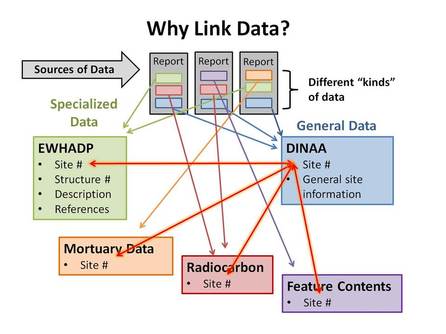
The DINAA project will benefit the archaeological community (and other constituencies) in a number of ways. Some of those are obvious now, and some will become apparent as we become able to think in practical terms about the power and potential of a large, unified dataset that integrates and crosscuts the traditional (i.e., state-level) territories within which archaeological site data are managed.

At the workshop this week, we spent some time thinking about ways to actually accomplish such a linking. The structure data I've been gathering is a good "test case" primarily because it spans the same area as the DINAA data and includes information from many sites (and is also open and freely accessible). Information needs to flow both ways. First, when a site record is called up in DINAA, it should be able to make a call to the EWHADP (and any other linked datasets) to see if there are records associated with that site number. Second, site/structure records in the EWHADP should include a pointer to the appropriate record in DINAA. The second part is simple: since the URLs associated with site records in DINAA are "stable," I can just put hyperlinks in my database that point to the DINAA record. The second part is a little trickier. Our first step was to put the current (as of March 2014) EWHADP database on GitHub (here) so that it would be open and accessible. GitHub automatically tracks when changes are made to a file. The next step (I think) will be to configure the GitHub page so that it sends a message to DINAA when the dataset changes. This will allow the records in DINAA to be updated as new records are added to the EWHADP.
It is the linking mechanisms that are important. The EWHADP data do not become a "part" of DINAA but are simply referenced by DINAA. I maintain control and responsibility for the EWHADP part of the equation. This is important because compilation of that dataset is ongoing: it's a database of records that I'm still collecting rather than something like a static set of measurements that relate to a single assemblage or site. I hope others who are developing similar datasets think about how we might link them all together through DINAA. The corpus of scholarship relevant to archaeological work in this part of the world is simply too large and diverse to live in a single place. A distributed approach using a "bridge" such as DINAA to link datasets is going to be much more effective and useful than trying to house everything in one central place.
We all have a lot to gain by supporting the construction of this tool. It is going to unleash the potential energy stored in the work we've already done and provide a "living" structure that will significantly increase our capacities to find, share, utilize, and build on archaeological information. The DINAA project needs to move forward in a big way.


 RSS Feed
RSS Feed
